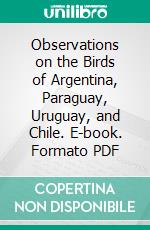Alexander Wetmore eBooks
eBooks di Alexander Wetmore
Observations on the Birds of Argentina, Paraguay, Uruguay, and Chile. E-book. Formato PDF Alexander Wetmore - Forgotten Books, 2017 -
The successful operation of the Federal Migratory Bird Treaty in according protection, hitherto uncertain, to migratory game and insectivorous birds, with resultant increase in many species, led naturally to inquiries regarding the present status of birds that migrate in winter beyond our borders. Particularly was this the case with those species, mainly shore birds, that pass south into the southern portion of the South American Continent. To gather first hand information on the questions involved the Biological Survey, United States Department of Agriculture, in May, 1920, dispatched the writer to Argentina with instructions to carry on the desired observations. During the extended period of field work incident to such a task there was abundant opportunity to make representative collections of native birds and to record many points of interest concerning their distribution and habits.Since observation of shore birds was the main object in mind, travel was restricted largely to the level sections where suitable shores and marshes were available, so that collections were made in the main in the lowlands. The area covered extended from northern Paraguay south to northern Patagonia, and from the eastern border of Uruguay west to the foothills of the Andes in Mendoza, and included a limited section near Valparaiso, Chile. Points for work were chosen carefully to allow comprehensive survey of as large an area as practicable. Studies of the specimens secured together with field observations, where pertinent, are presented herewith in as much detail as is warranted.
The Birds of Haiti and the Dominican Republic. E-book. Formato PDF Alexander Wetmore - Forgotten Books, 2017 -
Samaria Bay it is swampy with broad, wet savannas grown with palms, or extensive stretches of wet forest, penetrated with difficulty, that at the sea become mangrove swamps. The central mountain system of the island is a broken series of ridges and peaks that present no systematic arrangement to the eye of the traveller. The Cordillera Central, as it is known in the Dominican Republic, begins in a series of low hills in the arid eastern end of the island and extending westward broadens and be comes better watered until in its central portions it receives heavy downpours of rain. It continues through northern Haiti as the rugged Massif du Nord to a point northwest of Gros Morne, and at the south in Haiti is extended through the Montagnes Noires into the Sierra de Neiba that runs back into the Dominican Republic between the valleys of San Juan and Enriquillo. At the north the central mountain mass is limited by the Cibao Valley, while at the south in the Dominican Republic one spur reaches the vicinity of the sea at Sabana Buey. The system is 130 kilometers wide near its middle, and in its greatest extent is between 400 and 500 kilometers long. The summit of Loma Tina, in the Dominican Republic, near its center, reputed to be the highest mountain in the West Indies, is reported to rise meters above sea level, while Culo de Maco nearby is about its equal. Lorna Rucillo, also called Pico de Yaque, not far from Culo de Maco, is recorded as meters high. Broad stretches through these central mountains are covered with beautiful forests of pine mingled with areas of rain-forest jungle. The climate of the high interior valleys is invigorating, with hot days and cool nights, with occasional frost in the highest altitudes in winter. Rainfall is abundant in the Dominican Republic while to the west in Haiti the land is drier.

